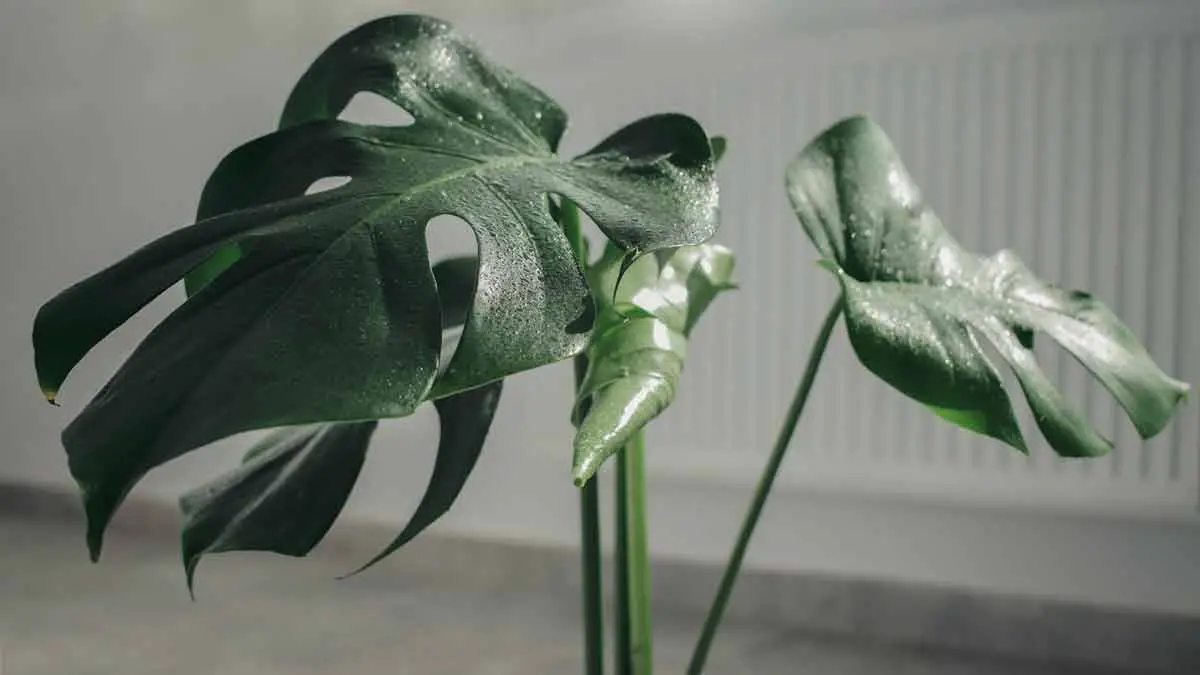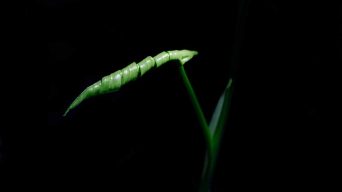Monstera plants have three growth stages: the sprout stage, the juvenile stage, and the adult stage. Depending on the species, it takes 1.5 to 8 years to reach maturity. Monstera plants can produce new leaves every 4-6 weeks with proper care and environmental conditions.
Monstera plants, often called the Swiss cheese plant or split leaf philodendron, have taken the world of indoor gardening by storm.
Their captivating, unique leaves with natural holes and splits create a stunning visual impact in any space they occupy.
But many enthusiasts may not know that these popular tropical plants go through several distinct growth stages, each requiring different care techniques for optimal health and development.
In this guide, we’ll explore Monstera leaf growth stages in detail to help you fully understand your beloved plant’s needs at every stage of its life cycle.
So sit back and prepare for an enlightening journey into the fascinating world of Monstera growth!
Understanding Monstera Leaf Growth Stages
Monstera plants have three distinct growth stages – the sprout stage, juvenile stage, and adult stage – each with unique characteristics and care requirements.
Sprout Stage
The sprout stage in Monstera leaf growth is an essential part of the germination phase, where the plant starts to emerge from its seed.
This initial development involves tiny roots forming and breaking through the seed’s outer shell to reach down into the soil for anchorage and nutrients.
During this crucial period, providing your Monstera with a warm and humid environment is important – ideal conditions for kickstarting healthy growth.
At this early stage, you’ll notice that young Monstera plants do not yet display their characteristic split leaves or fenestrations.
Instead, these delicate new sprouts focus on developing strong root systems and establishing themselves as they prepare for later stages of growth.
As a proficient gardener nurturing your Monstera plants from seeds, be patient and attentive during this foundational stage; proper care will set your precious sprouts up for success as they transition toward becoming juvenile plants with lush foliage.
Juvenile Stage
The juvenile stage is a critical period in the growth of Monstera plants, as it marks the transition from a tiny seedling to a mature houseplant.
During this stage, you will notice significant changes in leaf size and shape, with leaves displaying unique characteristics of different Monstera species, such as Monstera deliciosa and Monstera adansonii.
As the plant develops during this phase, the aerial roots of the Monstera plant may start becoming more prominent.
Monstera plants experience rapid growth throughout the juvenile stage due to their innate ability to adapt quickly to various environments.
This increased growth rate results in numerous new leaves emerging over time, gradually developing distinctive fenestration patterns typical for mature Monsteras.
Consequently, proper care and attention during this formative stage can significantly impact your plant’s overall health and appearance moving forward into adulthood.
Adult Stage
The adult stage is the final growth stage of a Monstera plant, where it reaches its full potential in terms of size and foliage.
During this stage, the plants require plenty of space as they can grow up to 10 feet tall indoors or even larger outdoors.
The leaves on an adult Monstera plant are generally split and fenestrated, which allows them to absorb more sunlight for photosynthesis.
Provide indirect sunlight and adequate water to care for your mature Monstera plant.
You can also support their growth using a moss pole or trellis to encourage aerial root development.
Be mindful of yellowing leaves, which may signal issues like overwatering or nutrient deficiencies.
With proper care during the adult stage, your Monstera plant will thrive for years to come.
What To Expect From Each Growth Stage
Each growth stage of the Monstera plant comes with its unique characteristics, including changes in leaf size and shape, development of fenestration, rate of growth, and signs of health and stress.
Changes In Leaf Size And Shape
As the Monstera plant progresses through its growth stages, leaf size, and shape changes become noticeable. The leaves of the sprout stage remain small for some time, usually measuring about 2-3 inches in length.
As the plant grows taller in the juvenile stage, so do the leaves; they get larger but retain their typical heart-shaped appearance.
In contrast, there is an evident difference in leaf size and shape at the adult stage, as fully-grown Monstera plants have more massive and irregularly shaped leaves.
Moreover, another fascinating feature accompanying changes in Monstera leaf size is their upward curling edges.
Unlike other houseplants with flat or downward-sloping leaves’ arrangement, mature Monstera leaves curl upwards along their margins as part of normal growth progression.
These unique shapes contribute to catching sunlight more effectively by providing different light surfaces to expose to direct and indirect sunlight sources while enhancing photosynthetic activities needed for healthy plants.
Leaf Development And Fenestration
Leaf development and fenestration are the most exciting stages of Monstera growth. Fenestrations, also known as “swiss cheese” holes, create the iconic look that makes the Monstera plant so beloved.
This process usually begins between 2 and 3 years of age when a mature leaf develops its first perforation.
A mature Monstera plant can have varying degrees of fenestration on its leaves, ranging from a couple to several large holes.
The attainment of the final size and shape of a Monstera leaf involves three significant developmental events: leaf initiation, expansion, and maturation.
The initiation phase is when the leaf first emerges from its sheath. During this time, it’s essential to provide adequate humidity since this ensures healthy foliage growth later in life.
As expansion progresses for juvenile plants into mature ones during their growing season, localized growth enhancement or suppression will occur.
This results in pinnately or palmately dissected leaves forming through processes within each cell according to specific genetic mechanisms influenced by environmental factors such as sunlight intensity or temperature levels!
The Growth Rate
The growth rate is an essential factor to consider when caring for your Monstera plant.
The plant will grow slowly during the seedling stage and produce only a few leaves each year.
However, once it reaches the juvenile stage, you can expect a faster growth rate with around 1-2 new leaves per month. As the plant matures into adulthood, it can produce 3 to 6 new leaves each month.
It’s essential to note that factors such as light intensity and temperature will affect how quickly your Monstera grows.
Providing bright indirect light and warm temperatures between 65-75°F can help maximize its growth potential.
On average, a Monstera takes about two years to reach maturity and produce fenestrated (holey) leaves.
Be patient with your plant’s growth rate and adjust its care based on any noticeable changes in leaf development or overall health.
Signs Of Health And Stress
Monstera plants are known for their stunning leaves, but like any other plant, they can also show signs of poor health and stress.
One common sign is the yellowing of leaves, indicating overwatering or lack of nutrients.
If the leaves start to curl or brown on the edges, it could indicate high levels of direct sunlight exposure.
Another critical indicator of Monstera plant health is the presence or absence of aerial roots.
These roots are essential in supporting the plant’s growth and obtaining water and nutrients from its surroundings.
Insufficient watering or low humidity levels can cause root rot, leading to decayed stems and unhealthy foliage.
By monitoring these signals closely, you can help ensure that your Monstera stays healthy and continues to flourish throughout its growth stages.
Caring For Your Monstera Plant At Each Growth Stage
This section will provide you with essential care tips for each growth stage of your Monstera plant, so you can ensure that it thrives as it progresses from a sprout to an adult.
Read on to discover how to maximize its growth potential and keep it healthy!
Care Tips For The Sprout Stage
Monstera plants require special care during the sprout stage to ensure healthy and robust growth.
Here are some tips to help your sprouts thrive:
- Keep the soil moist but not waterlogged: Maintaining a consistently moist soil environment during this stage is essential, as excessive moisture can cause root rot. Use well-draining soil with good water retention properties.
- Provide indirect sunlight: While young shoots need bright light for photosynthesis, direct sunlight can scorch their delicate leaves. Place them in a partially shaded spot or use sheer curtains to filter out harmful rays.
- Use a humidity tray or mist regularly: Monstera plants love humid environments and benefit from increased humidity levels during their early stages of growth. A humidity tray filled with water or regular misting will help keep the air around your plant moist.
- Protect from pests and diseases: At this vulnerable stage, even minor infestations or diseases can stunt growth or kill off new shoots altogether. Check for signs of spider mites, mealybugs, scale insects, and treat promptly if you see any problems.
- Avoid overfertilization: Overfeeding your sprouts may seem like a good idea, but it can do more harm than good at this point in their development cycle. Use a balanced fertilizer sparingly (once every 6-8 weeks) until they reach maturity.
Remember that proper care given at each growth stage of the Monstera plant holds the key to its long-term health and prosperity as it grows into adulthood!
Care Tips For The Juvenile Stage
During the juvenile stage of Monstera growth, it is crucial to provide proper care to ensure healthy development. Here are some care tips for the juvenile stage:
- Keep soil moist but not soggy: Monstera plants require well-draining soil that is consistently moist during the juvenile stage. However, overwatering can lead to root rot and other issues
- Water when topsoil is dry: It’s recommended to water your Monstera plant when the top half-inch of soil feels dry to the touch. This will help prevent problems associated with overwatering.
- Provide bright indirect or filtered light: During active growth periods in spring and summer, Monstera plants need plenty of light for optimal growth. Bright indirect or filtered light is ideal for providing enough energy while avoiding direct sunlight, which can scorch leaves.
- Maintain optimal temperature and humidity levels: Monstera plants prefer temperatures between 65-80°F (18-27°C) with humidity levels around 60%. Keeping this environment stable helps promote healthy growth during the juvenile stage.
- Feed with appropriate fertilizer: Monstera plants benefit from regular fertilization using a balanced fertilizer such as a general-purpose houseplant food. It’s best to feed every 2-3 weeks during active growth periods in spring and summer.
Following these care tips during the juvenile stage can help your Monstera plant grow into a healthy adult with beautiful fenestrated leaves that will bring life and color to any indoor space!
Care Tips For The Adult Stage
During the adult stage, Monstera plants require specific care to thrive. Here are some tips to keep your Monstera healthy:
- Water: Keep the soil consistently moist but not soggy. Overwatering can cause root rot and lead to yellowing leaves.
- Light: Provide bright indirect or filtered light during the plant’s active growing season (spring through fall). In winter, when the sun is less intense, direct light can be provided.
- Humidity: Monstera plants prefer high humidity levels (around 50-60%). You can increase humidity by misting the leaves regularly or using a humidifier.
- Fertilizer: Feed your Monstera with a balanced fertilizer every 2-3 weeks during its active growing season.
- Repotting: As your Monstera grows, it may outgrow its pot and require repotting. When repotting, use well-draining soil and a container slightly larger than the previous one.
- Pruning: Regularly prune any yellowing or damaged leaves to promote new growth and maintain plant health.
- Support: As Monstera plants grow taller, they may require support from a moss pole or trellis to prevent the stem from bending or breaking.
By following these care tips for the adult stage of Monstera growth, you can ensure that your plant thrives and continues to produce beautiful fenestrated leaves.
Maximizing Growth With Proper Care
To maximize the growth of Monstera plants, it’s essential to provide them with appropriate care at each growth stage.
For sprouting plants, ensure they receive bright indirect light and are kept in a warm room with high humidity.
Use a well-draining soil mix for juvenile plants and water them every 1-2 weeks, allowing the soil to dry out between watering sessions.
For mature Monstera plants, exposure to bright indirect light is crucial for maintaining healthy leaves and encouraging further growth.
One way to promote growth is by training the Monstera plant to climb up a moss pole or other type of trellis, which also helps prevent root rot by providing better air circulation around the roots.
Following proper care techniques at each growth stage and paying attention to signs of stress or disease can help your Monstera plant reach its full potential for lush greenery at any size.
Final Thoughts
In conclusion, understanding the growth stages of Monstera plants is crucial in ensuring they receive the proper care they need to continue thriving.
Each stage comes with its own set of unique characteristics and requirements for optimal growth.
Whether your Monstera plant is in the sprout, juvenile or adult stage, maximizing its potential requires ample water, light, and humidity and providing support like a moss pole where necessary.
With patience, attention to detail, and a little TLC, you can enjoy beautiful, healthy Monsteras for many years!







